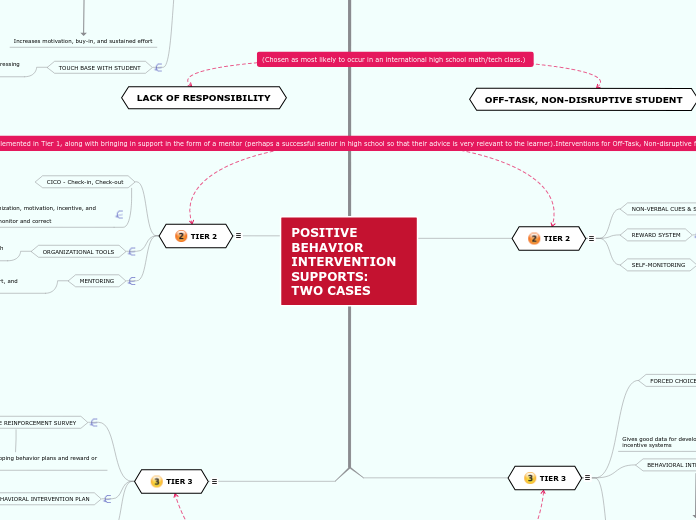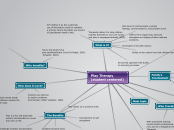LACK OF RESPONSIBILITY
OFF-TASK, NON-DISRUPTIVE STUDENT
POSITIVE BEHAVIOR INTERVENTION SUPPORTS: TWO CASES
BEHAVIOR MEETINGS
MENTORING
Improves student motivation
Source of accountability, encouragement, support, and advocacy
ORGANIZATIONAL TOOLS
Increases student responsibility and follow through
Holds students more accountable
CICO - Check-in, Check-out
Improves student organization, motivation, incentive, and reward
Helps students to self monitor and correct
Data Tracking -Tier 1
For students: Self-monitoring assignment sheet or if some behaviors, organization and assignments need to be monitored, then a tracking form could be created specifically for the individual. It's important that the tracking be largely student monitored since the age group is high school, and independence is an important theme for students at this stage.
For teachers: Tier 1 Intervention General Tracking form would provide the documentation of interventions attempted over time.
TOUCH BASE WITH STUDENT
Keeps students moving forward, motivated, and progressing
Holds students accountable
REWARDS
Increases motivation, buy-in, and sustained effort
MORE STRUCTURED ROUTINES
increases work production, compliance, & engagement
HELP STUDENT START ASSIGNMENT
Improves students’ perceptions of the work and assignments
Increases student willingness and participation
TIER 3
Data Tracking -Tier 3
For students: Student Progress Self-Evaluation and/or Self-Assessments could be given if they have not already been administered in Tier 2. Providing students with a self-referral form to the counselor would also be a good idea; high school students want to feel like they have choices. In line with that, the Forced Choice Survey should be administered to students during Tier 3 as well.
For teachers: At this point, it would be time to call in the School Counselor and/or the Behavior Intervention Specialists through the use of the referral forms for the school/district. Teachers could use information gathered from Scatter Plots and other data tracking in Tiers 1-2 to complete a Functional Behavior Assessment. Teacher would also want to continue tracking the progression of interventions and results from Tier 1 to Tier 2 to Tier 3 on an online platform or electronic form such as PBISWorld Behavior and Intervention Tracking form. If the school has the Google Suite, a shared tracking form could be created to document interventions being implemented by all teachers who work with that student.
BEHAVIORAL MEETINGS
When students are age appropriate and involved in meetings, they tend to take interventions more seriously, feel included, and are held directly responsible from the parties involved
BEHAVIORAL INTERVENTION PLAN
Provides more intensive intervention and monitoring
Increases support around student
Provides an individualized plan for success
FORCED CHOICE REINFORCEMENT SURVEY
Gives good data for developing behavior plans and reward or incentive systems
TIER 2
Data Tracking -Tier 2
For students: Daily (if necessary) or weekly Check In, Check Out forms for the student would serve as self-monitoring (given the ages of those in high schools classes). After some time, Student Progress Self-Evaluation and/or Self-Monitoring Assignment sheets could be given, which would hopefully help address the issue of responsibility.
For teachers: Check In, Check Out Data Summary forms would help the teacher compile and track the student's performance over time on the CICO intervention. Teacher would also want to continue tracking the progression of interventions and results from Tier 1 to Tier 2 on an online platform or electronic form such as PBISWorld Behavior and Intervention Tracking form. If the school has the Google Suite, a shared tracking form could be created to document interventions being implemented by all teachers who work with that student.
SELF-MONITORING
Improves on task behaviors
Increases productivity
Improves self awareness and reflection
REWARD SYSTEM
Increases on task and attending behaviors
NON-VERBAL CUES & SIGNALS
Creates a working relationship with student without calling attention to the student in a negative manner
Main topic
TIER 1
Data Tracking -Tier 1
For students: A self-monitoring behavior sheet could be created specifically for the student to help them become more self-aware. It's important that the tracking either be largely student monitored or subtly monitored by the teacher, since the age group is high school, and independence is an important theme for students at this stage.
For teachers: Tier 1 Intervention General Tracking form or an online platform like LiveSchool would provide the easy yet unobtrusive documentation of interventions attempted over time.
LOGICAL CONSEQUENCES
Teaches students to take responsibility for their choices
It teaches that when an action occurs, a consequence follows Are similar to what would happen to an adult in a comparable situation
PROXIMITY
Can be a subtle re-direction technique
FREQUENT EYE CONTACT
Provides off task, disruptive, inattentive, and other students with a non-verbal cue to stop what they are doing and get back on task
Is a subtle way to address behaviors and students without drawing a lot of attention (very important for working with high school students)
PRAISE WHEN ON TASK
It helps keep students engaged









